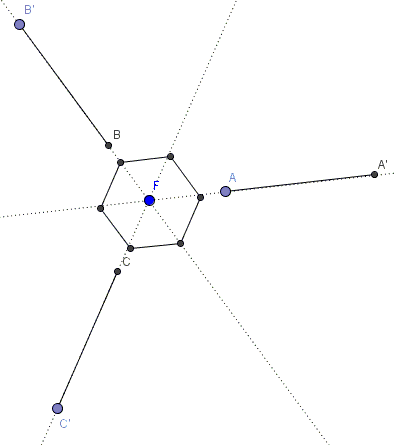Fermat's Hexagon
What is this about?
Problem
Let $AA',\;$ $BB',\;$ and $CC'\;$ be three equal line segments lying on concurrent lines at $120^{\circ}$ to each other. Define centroids $G_A,G_B,G_C,K_A,K_B,K_C\;$ of triangles $BCA',\;$ $CAB',\;$ $ABC',\;$ $AB'C',\;$ $A'BC',\;$ $A'B'C,\;$ respectively.

The hexagon $G_AK_CG_BK_AG_CK_B$ is regular.
Hint
A look at a related page may prove useful. But so are complex numbers.
Solution
I am going to associate complex numbers with the six given points. Assuming $g$ is the the rotation around the origin through $120^{\circ}$ degrees in the positive direction: $g^3=1,$ and $u,v,w,d$ are fixed real numbers, let's say,
$ \begin{align} A &= u, \\ A' &= u+d, \\ B &= gv, \\ B' &= g(v+d), \\ C &= -gw, \\ C' &= -g(w+d). \end{align} $
Calculating the centroids gives (without the fator $1/3$):
$ \begin{align} G_A &= u+d+gv-gw, \\ G_B &= u+g(v+d)-gw, \\ G_C &= u+gv-g(w+d), \\ K_A &= u+g(v+d)-g(w+d), \\ K_B &= u+d+gv-g(w+d), \\ K_C &= u+d+g(v+d)-gw. \end{align} $
Now it is easy to verify that, say,
$ \begin{align} G_AK_B &= -gd = G_BK_A, \\ G_AK_C &= gd = G_CK_A, \\ G_BK_C &= d = G_CK_B, \end{align} $
which is actually exactly what is needed to establish the assertion.
Acknowledgment
The problem is a generalized reformulation of a post by Dao Thanh Oai at the CutTheKnotMath facebook page.
Napoleon's Theorem
- Napoleon's Theorem
- A proof with complex numbers
- A second proof with complex numbers
- A third proof with complex numbers
- Napoleon's Theorem, Two Simple Proofs
- Napoleon's Theorem via Inscribed Angles
- A Generalization
- Douglas' Generalization
- Napoleon's Propeller
- Napoleon's Theorem by Plane Tessellation
- Fermat's point
- Kiepert's theorem
- Lean Napoleon's Triangles
- Napoleon's Theorem by Transformation
- Napoleon's Theorem via Two Rotations
- Napoleon on Hinges
- Napoleon on Hinges in GeoGebra
- Napoleon's Relatives
- Napoleon-Barlotti Theorem
- Some Properties of Napoleon's Configuration
- Fermat Points and Concurrent Euler Lines I
- Fermat Points and Concurrent Euler Lines II
- Escher's Theorem
- Circle Chains on Napoleon Triangles
- Napoleon's Theorem by Vectors and Trigonometry
- An Extra Triple of Equilateral Triangles for Napoleon
- Joined Common Chords of Napoleon's Circumcircles
- Napoleon's Hexagon
- Fermat's Hexagon
- Lighthouse at Fermat Points
- Midpoint Reciprocity in Napoleon's Configuration
- Another Equilateral Triangle in Napoleon's Configuration
- Yet Another Analytic Proof of Napoleon's Theorem
- Leo Giugiuc's Proof of Napoleon's Theorem
- Gregoie Nicollier's Proof of Napoleon's Theorem
- Fermat Point Several Times Over
![]()
|Contact| |Front page| |Contents| |Geometry|
Copyright © 1996-2018 Alexander Bogomolny73549545
